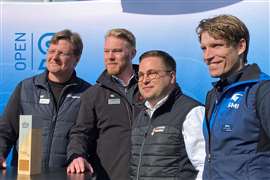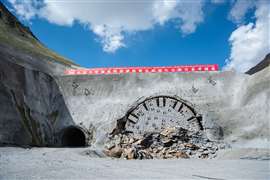Himoinsa interview: Francisco J Gracia, executive director.
17 December 2013

Already an international business, Himoinsa continues to invest in expanding its production footprint worldwide. Murray Pollok visited the company at its headquarters in Murcia, Spain and spoke to Francisco J Gracia, executive director.
Himoinsa is fortunate in having far-sighted owners. Francisco J Gracia, executive director of the company and son of founding chairman Francisco Gracia, recalls a conversation with his father in which he talked about the need to “balance the company”.
“He anticipated the situation we are facing in Europe”, Mr Gracia tells IRN, “We need to focus on the generator business, but diversify the market. We can lose one market, but not all of them.”
In practical terms this meant investing in export before it became a necessity or, worse, a matter of survival. That strategy has meant that Himoinsa - based in Murcia, southern Spain, and founded in 1982 – has turned itself from a company that in 2000 had an 85% reliance on Spain and Portugal into an operation where Spain now represents 5% or less of its US$300 million business.
“The key is to be flexible to market needs – you have to offer products the market wants in different regions”, he says to IRN during Himoinsa’s Asia Pacific dealer meeting in Spain in late September.
That has means enormous investments in production facilities worldwide. In addition to its three facilities in Spain and one in France (the Genelec operation), Himoinsa has an alternator facility in Argentina, an assembly plant in Kansas, US, a factory in India and another in China. In the latter, the full range of generators and lighting towers is produced.
Mr Gracia says the company has invested more than €50 million over the past five years; “The philosophy is to reinvest profits every year, constant reinvestment.” The strategy is paying off, with revenues growing annually at an average rate of 5 to 8%, which is lower than the 10-15% growth rates it was experiencing before the crisis, but still more than respectable.
The scale of investment also reflects Himoinsa’s policy of vertical integration, whereby it makes most of its own components – canopies, electronics, alternators – although not engines. (It will also source alternators from other suppliers like Mecc Alte, when requested.)
Mr Gracia says this approach pays off in terms of production flexibility: it is not reliant on third party suppliers if it wants to increase production capacity or change components. “Sometimes we wouldn’t have grown as fast as we have with our own suppliers. In our factories we have machine tools working only for Himoinsa.”
That policy, and the investment in production facilities that it requires, will continue. Mr Gracia says the next initiative is an assembly plant in Belo Horizonte, Brazil, which will use canopies and electrics imported from other Himoinsa facilities and alternators from its plant in Argentina. Around 60% of the content will be local. It is a modestly sized facility, around 3000 m2, and will produce between 500 and 1000 units a year from 20 kVA up to 700 kVA.
“The rental market is a key market, one of the main targets globally, but also in Brazil. However, we want to diversify beyond rental in Brazil”, he says, “There are concerns about rental after the World cup and Olympics. We need to balance rental with the standby market.”
Perhaps even more important is the plan to expand its US operation, based in Kansas. An investment of around US$25 million will see the company open a sheet metal fabrication facility that will increase the local content – canopies are currently imported to the US – and increase production capacity by around seven or eight times. It will also make its gensets more competitive, says Mr Gracia. That facility should be up and running by 2015.
North America and its high-spending rental sector is already a major market for Himoinsa – accounting for around a fifth of revenues – and Mr Gracia says it has the potential to be much bigger and is a very “strategic market”.
With Europe likely to be flat over the coming years and African growth gradual rather than dramatic, it is North America and Asia Pacific that Mr Gracia says represent “the meat on the barbeque. All markets are important, but we think we can grow faster in these two areas.”
Currently Europe, the Middle East and Africa represent 55% of Himoinsa’s sales, with the Americas at 30% and Asia Pacific and India and 15%. Mr Gracia says an equal third share between the three regions is what he would prefer within five years, meaning that Asia Pacific needs to expand. In that same period the company aims to double revenues to €500 million.
The company hopes that working with good distributors in Asia will help it grow, although the competition from low cost Chinese suppliers makes it difficult. Himoinsa has some strong partners, such as the RMA Group in Thailand and Myanmar – a business that now has its own rental operations – and Tuyet Nga Co Ltd (TNC) in Vietnam, a sales and rental company. In Australia it has respected distributors in Crommelins Machinery (for the west of the country) and Generator Power (in the east).
One important element of the Asia Pacific strategy is the launch of a new range of gensets using engines made by Wuxi Diesel, a subsidiary of Chinese automotive and truck manufacturer FAW Group.
This is a departure from its usual strategy, and Himoinsa is careful to emphasise that the new range will not compete with its existing Chinese built gensets – produced at its plant in Changzhou - but will address the 30% of the Asia Pacific genset market that uses lower cost engines produced by Chinese suppliers. Himoinsa says it cannot currently compete in this segment.
The company said it has looked long and hard at the Wuxi Diesel operation and says the gensets, although cheaper, will be subject to the same degree of testing and quality control that it applies to all its products.
“We need to enter this 30% of the market to maintain sustainable growth”, says Manuel Inglés, managing director of Himoinsa China. The engines will be branded Himoinsa and will be supported and serviced by the company in the same way as with its other gensets.
“We are talking about a two-digit price reduction”, says Mr Inglés, “We will make it competitive.”
Although the target market for the gensets will be Asia Pacific Himoinsa said it would consider requests for the units from other markets where low emission engines are not required, such as South America.
The range, which will be in production by January next year, will comprise seven 50 Hz models in 20 to 100 kVA sizes and seven 60 Hz versions from 32 to 123 kVA. Gensets up to 200 kVA are also being developed. The generators will use the same canopies as other Himoinsa engines and will have M7X panel controllers, a lower cost version of the CM7 controller.
If that development is targeted at boosting its Asia Pacific business, Himoinsa is also intent on strengthening its offering in the large power projects sector.
Here, Himoinsa has entered into a partnership with the specialist German generator builder Frerk Aggregatebau, which will produce specialist heavy fuel oil, low engine speed, containerised units for Himoinsa for use in large power projects. Frerk will make sets in the 500 to 8000 kVA range, including 4 MW units in 40 ft containers.
Mr Gracia says the joint venture is important, giving Himoinsa the capacity to build and test very large sets that it can’t currently handle in-house. He also clarifies that Himoinsa is not interested in entering the IPP power rental market, but will instead be looking for opportunities to sell large units or install permanent power plants. (A recent example is a 20 MW facility in Angola, which Himoinsa will manage for a period before handing over to the client.)
Himoinsa is also happy to make strategic partnerships as a manufacturing supplier. For example, in produces Yanmar branded gensets for the Japanese company to sell in its home market, and also has an important agreement with JCB to produce gensets and lighting towers.
It also has an agreement with JCB to manufacture gensets and lighting towers for the UK manufacturer's Power Products division. Himoinsa and Mr Gracia will not talk about this agreement, but it is fair to say that it is significant, particularly given JCB's recent move to expand sales of gensets and lighting towers worldwide.
That is another example of how Himoinsa is targeting rental markets. The company has a large standby generator business as well as large power projects, but rental represents between 20% and 25% of total sales, and is likely to grow, says Mr Gracia. “It will increase in North America and Asia Pacific”.
So there is a lot going on at the company, with new factories, new products and new technology. However, Mr Gracia says Himoinsa will remain a family-owned business; “We want to be multi-national company, but a family-owned multi-national.”
And there is no desire to branch out into other portable power products such as compressors. “Pumps, compressors, they are not interesting to us. We want to be focused on power generation and energy – that is what we know and that is what we do.”
BOX STORY
Europe strategy
Francisco Inglés, Himoinsa’s sales manager for Europe, says the company had to completely change its strategy when the crisis hit its sales to Europe’s rental sector.
In the boom years, rental was a key market for the manufacturer, with standby power applications representing little more than 20% of its business. Now, that non-rental market accounts for 60-65% of its business in Europe.
“We were focused on rental, prime power”, he says, “but we had to convert to standby. The crisis taught us that we have to become more flexible, try to find new niches, niches that existed but we didn’t pursue.”
He is adamant that rental remains a cornerstone for Himoinsa in Europe. “We have not forgotten rental at all – we developed the PowerCube for rental, and extended our rental range up to 660 kVA.”
Mr Inglés, who has spent almost 15 years with Himoinsa, says there are signs that Europe is improving, although he remains realistic about growth prospects.
He says the company performs best where it has its own subsidiary, a fact that has led the company to create a UK subsidiary, led by former SDMO sales manager Clive Dix. The business will be fully operational at the start of 2014, adding to the existing Himoinsa companies already operating in Germany, Poland, France and Italy.
He is also optimistic about the compact, 500/600 kVA PowerCube; “It’s not very well known yet, but it will be very interesting to rental companies because its small – easy for stacking – and has low noise levels.”






